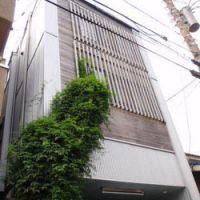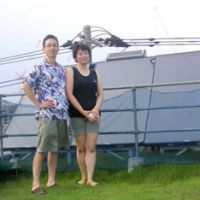Sporting a smart, modern exterior, the home of Keiko and Yoshiyuki Shimizu and their children Ayano, 13, and Haruki, 11, in a residential area of Kawasaki, south of Tokyo in Kanagawa Prefecture, is full of fun features inside. The three- story house has a grassy garden on its flat roof, where you can have a nap or a barbecue on sunny days. It also has a little corner where the couple grow vegetables and herbs for their dinner table.
The rooftop garden with its 15-cm layer of soil also works as a natural air conditioner, insulating the house from summer's heat and conserving its warmth in winter. The water that flows through the solar-heating panels on the side of the roof not only supplies the couple's washing and kitchen needs, but is also circulated under the floor to heat the entire building during winter.
The second-floor kitchen/living room, featuring pesticide-free tatami mats, has the feel of a mountain cabin, thanks to walls and columns made of pine. Its two-story ceiling makes it possible for Keiko, while working in the kitchen, to be aware of the children playing or studying upstairs.
The 500 pieces of washi paper covering the walls — all of which the couple made from scratch at a paper factory in Tokyo — also keep the house interior dry, as the material excels in absorbing humidity, Keiko, 42, said.
The house, which the family moved into in the summer of 2004, is spacious — with 131 sq. meters of floor area, three times more than the rented apartment they moved from. Yet, due to its combination of ecological features — the rooftop garden, the solar-water heater, the water-saving faucets, toilets and shower heads, the double-glazed windows and heat-insulating resin window frames — the electricity bills have stayed at about ¥10,000 a month, the same as at their previous home.
The family expects to have their investment in the solar water heater recouped in 10 years, as it saves around ¥5,000 in utility bills every month. They have also received subsidies for green housing totaling ¥1.3 million from the city of Kawasaki and the New Energy and Industrial Technology Development Organization, a government-affiliated energy research institute.
Keiko, an engineer at a major electronics company, said she became interested in an ecological house because of her background as a thermal-power specialist.
"Because I'm involved in the development of thermal-power plants, I think about the use of energy every day, and I hate wasting energy," said Keiko. She also pointed out that she takes other measures to keep electricity costs down, such as using a rice cooker outdoors by plugging it into a socket on the outside wall — so avoiding heating up the inside of the house and then having to pay to cool it again.
But Keiko, who has a doctoral degree in engineering, is no eco-zealot, and insists, "I also want to live in a way so you don't have to completely deny the convenience of modern life."
When the couple decided to have their house built, they consulted Sachiko Zenyoji, an architect who specializes in designing eco-houses, and together they drew up the plans. While the house cost ¥40 million to build, the Shimizu family is very happy with their home.
"Our home is ecological but our lives have not been inconvenienced greatly," Keiko said. "In the future, we would like to recycle our bath water and experiment with solar and wind power."




